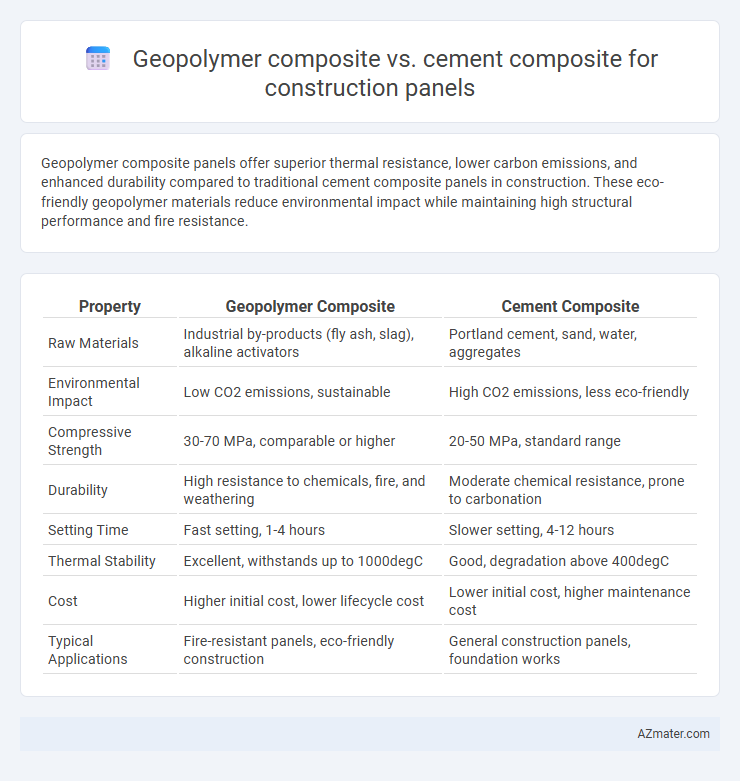Geopolymer composite panels offer superior thermal resistance, lower carbon emissions, and enhanced durability compared to traditional cement composite panels in construction. These eco-friendly geopolymer materials reduce environmental impact while maintaining high structural performance and fire resistance.
Table of Comparison
| Property | Geopolymer Composite | Cement Composite |
|---|---|---|
| Raw Materials | Industrial by-products (fly ash, slag), alkaline activators | Portland cement, sand, water, aggregates |
| Environmental Impact | Low CO2 emissions, sustainable | High CO2 emissions, less eco-friendly |
| Compressive Strength | 30-70 MPa, comparable or higher | 20-50 MPa, standard range |
| Durability | High resistance to chemicals, fire, and weathering | Moderate chemical resistance, prone to carbonation |
| Setting Time | Fast setting, 1-4 hours | Slower setting, 4-12 hours |
| Thermal Stability | Excellent, withstands up to 1000degC | Good, degradation above 400degC |
| Cost | Higher initial cost, lower lifecycle cost | Lower initial cost, higher maintenance cost |
| Typical Applications | Fire-resistant panels, eco-friendly construction | General construction panels, foundation works |
Introduction to Geopolymer and Cement Composites
Geopolymer composites consist of inorganic polymers derived from aluminosilicate materials activated by alkaline solutions, offering enhanced durability and eco-friendly properties compared to traditional cement composites. Cement composites are primarily composed of Portland cement mixed with aggregates and water, forming a hardened matrix widely used in construction panels for its strength and workability. Geopolymer composites exhibit superior resistance to chemicals and thermal degradation, making them a promising alternative in sustainable construction panel applications.
Key Material Components and Formulation
Geopolymer composites utilize aluminosilicate materials such as fly ash, metakaolin, and slag activated by alkaline solutions like sodium hydroxide and sodium silicate, offering a lower carbon footprint compared to traditional cement composites. Cement composites primarily consist of Portland cement, sand, aggregates, and water, with hydration reactions forming calcium silicate hydrate (C-S-H) as the main binding phase. The geopolymer formulation enables enhanced thermal resistance and chemical durability by forming a three-dimensional aluminosilicate network, whereas cement composites rely on calcium-based hydration products for mechanical strength and setting characteristics.
Environmental Impact and Sustainability
Geopolymer composites significantly reduce carbon emissions by utilizing industrial by-products like fly ash and slag, resulting in up to 80% lower CO2 footprint compared to traditional cement composites. Their high durability and resistance to chemical attacks enhance the service life of construction panels, minimizing resource consumption and waste generation over time. Geopolymer panels demonstrate superior sustainability by promoting circular economy practices through the use of recycled materials and reducing dependency on virgin raw materials essential to cement production.
Mechanical Properties Comparison
Geopolymer composites exhibit higher compressive strength and improved flexural strength compared to traditional cement composites, enhancing durability and load-bearing capacity in construction panels. Their superior resistance to thermal degradation and chemical attacks makes them more suitable for harsh environments, extending panel lifespan. Additionally, geopolymer composites demonstrate better volume stability and reduced shrinkage, minimizing crack formation and improving mechanical performance overall.
Durability and Lifespan
Geopolymer composites exhibit superior durability compared to cement composites due to their enhanced resistance to chemical attacks, high temperatures, and reduced permeability that minimizes water ingress and corrosion of embedded reinforcements. Studies indicate geopolymer panels can have a lifespan exceeding 50 years with minimal maintenance, outperforming traditional cement composites which often degrade within 30-40 years under similar environmental conditions. The intrinsic alkali-activated chemistry of geopolymers provides long-term structural stability and resistance to carbonation and sulfate attack, key factors influencing panel longevity in construction applications.
Thermal and Fire Resistance
Geopolymer composites exhibit significantly higher thermal stability and fire resistance compared to traditional cement composites, maintaining structural integrity at temperatures exceeding 1000degC due to their inorganic polymer matrix. The aluminosilicate-based geopolymer matrix enhances fire resistance by forming a dense, non-combustible microstructure that minimizes thermal conductivity and prevents crack propagation under thermal stress. In contrast, cement composites typically experience strength degradation and microcracking above 300degC, limiting their application in high-temperature environments for construction panels.
Cost Analysis and Economic Feasibility
Geopolymer composites exhibit lower raw material costs due to the utilization of industrial by-products like fly ash and slag, reducing reliance on expensive Portland cement in construction panels. The reduced energy consumption during geopolymer synthesis translates to significant operational savings, making the production cost-competitive with traditional cement composites. Long-term economic feasibility is further enhanced by geopolymer panels' superior durability and lower maintenance costs, positioning them as a cost-effective alternative in sustainable construction.
Applications in Construction Panels
Geopolymer composites offer enhanced fire resistance, lower carbon emissions, and superior durability compared to traditional cement composites when used in construction panels. These panels are ideal for applications requiring sustainable building materials, such as exterior cladding, load-bearing walls, and acoustic insulation. Cement composite panels remain popular for general construction due to their cost-effectiveness and established manufacturing processes but fall short in environmental impact and chemical resistance compared to geopolymer alternatives.
Challenges and Limitations
Geopolymer composites face challenges such as variability in raw material sources and limited long-term durability data compared to cement composites, which can affect consistency in construction panels. The high alkalinity of geopolymer mixtures requires specialized handling and curing conditions, increasing complexity and costs relative to traditional cement panels. Additionally, the lack of standardized codes and industry acceptance limits the widespread adoption of geopolymer composite panels despite their potential environmental benefits.
Future Trends and Innovations
Geopolymer composites are gaining traction over traditional cement composites due to their lower carbon footprint and enhanced durability, aligning with sustainable construction goals. Innovations such as incorporating nano-materials and industrial by-products into geopolymer matrices are improving mechanical properties and thermal resistance, driving higher performance in construction panels. Future trends emphasize digitization in manufacturing processes and hybrid composites combining geopolymer with cement to optimize cost-efficiency and material functionality.

Infographic: Geopolymer composite vs Cement composite for Construction panel
 azmater.com
azmater.com